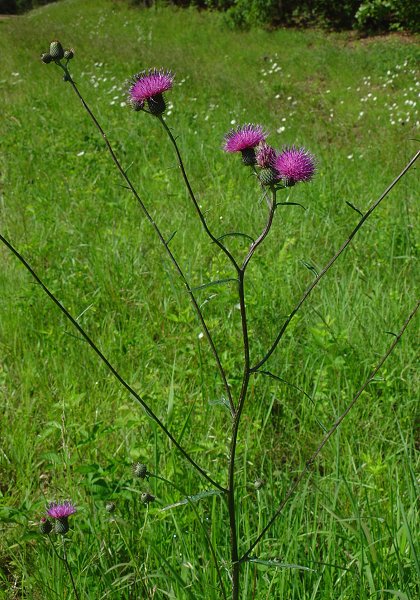Cirsium carolinianum (Walter) Fernald & B.G. Schub.
Carolina Thistle

Native
CC = 8
CW = 5
MOC = 15
© DETenaglia
Cirsium carolinianum (Walter) Fernald & B.G. Schub.Carolina Thistle | |
 |
Native CC = 8 CW = 5 MOC = 15 |
© DETenaglia |
|
Family - Asteraceae/Cardueae Habit - Biennial or short-lived perennial forb, with a short, inconspicuous taproot in addition to the often somewhat thickened, fibrous roots. Stems - Erect, to 1.5 m, often branched, hollow, glabrous or with patches of cobwebby hairs, lacking spiny wings.
Leaves - Basal and alternate, with spiny margins. Basal leaves petiolate, 8-30 cm long, 1-3 cm wide, narrowly lanceolate to narrowly oblanceolate or linear, tapered at the base, mostly sharply pointed at the tip, unlobed or less commonly with a few narrow, irregular lobes below the midpoint, the margins otherwise toothed or wavy and spiny, the upper surface appearing green, nearly glabrous to moderately pubescent with stiff, straight hairs, the undersurface appearing white, densely pubescent with felty hairs. Stem leaves progressively reduced from the stem base, mostly sessile, those along the upper 1/3 sparse and widely spaced, mostly 1-15 cm long, linear-oblong, all unlobed or the lower ones with a few narrow, irregular lobes below the midpoint, tapered to an often slightly expanded base, otherwise like the basal leaves.
Inflorescence - Heads usually relatively few, solitary at the branch tips, appearing long-stalked. Peduncles cobwebby-pubescent, naked, each typically subtended by a small foliaceous bract, these cobwebby-pubescent and prickle-margined. Heads - Involucre 15-20 mm long, as long as or slightly longer than wide, often somewhat cobwebby-hairy. Involucral bracts imbricate, tightly appressed, the lower and median bracts often with a conspicuously whitened area along the midrib, tapered to a loosely ascending to spreading, spiny tip, this 1.5-4.0 mm long, straw-colored to light yellow.
Ray flowers - Absent. Disk flowers - Corollas 15-24 mm long, pinkish purple to reddish purple, whitened at base, glabrous, the 5 lobes 4-7 mm long. Pappus of white plumose bristles 12-17 mm long, white or occasionally slightly grayish-tinged. Stamens 5. Anthers pinkish-purple, fused around style, typically exserted. Style rose-pink, well exserted, glabrous, 2.6 cm long.
Fruits - Achenes, 3-4 mm long. Flowering - May - June. Habitat - Forest openings, bluffs, roadsides, usually on acidic substrates. Origin - Native to the U.S. Lookalikes - Broadly, other thistles. Other info. - The Missouri range of this species is tightly clustered in the eastern Ozark region. Beyond Missouri it extends mostly south and east. It is neither rare nor frequently encountered. This is one of the easier thistles to identify, having narrow and mostly entire stem leaves and sticky involucral bracts with conspicuously whitened midribs and long spines. It would make a good garden subject as it requires little care and is far less spiny than most other members of the genus. Photographs taken CR 160-152, Mark Twain National Forest, Oregon County, MO., 7-14-00, and in Ellington, MO., 5-26-03 (DETenaglia); also at Hawn State Park, Ste. Genevieve County, MO, 5-1-2010, St. Joe State Park, St. Francois County, MO, 5-15-2017, and Shut-in Mountain fen, Shannon County, MO, 5-19-2023 (SRTurner). |